A table read is one of the most important steps in the production process for any feature film or TV series.
You’ve poured your heart and soul into your screenplay, you’ve collected feedback and you’re ready to send it out into the world.
But before you unleash your carefully crafted words, have you ever heard them spoken aloud?
A table read puts your screenplay at a huge advantage and can be crucial to its success. It can even be considered one of the most important parts of your scriptwriting and selling process.
Whether you’re a first-time writer or a film industry veteran, table reads can give you invaluable insight into your script.
Table of Contents
- What is a Table Read/Read-Through?
- Identify Problem Areas in A Script
- Take Notes During a Table Read
- Gain Feedback During a Table Read
- Use Notes from the Table Read for Rewrites
- A Table Read Can Confirm Casting Decisions
- Gather Everyone Together at the Table Read
- Set the Tone For the Production
- Building the Excitement of Current Investors and Attracting New Ones
- Marketing Benefits
- Table Reads Can Be Helpful at Early Stages of Script Development
- In Conclusion
- In Summary
What is a Table Read/Read-Through?
A table read (also known as a read-through) is an organized reading of a script in which the speaking parts, stage directions, and scene headings are read out loud.
Gathering the cast, writer(s), and director together offers the opportunity for everyone to hear the story out loud, take notes, and come together afterwards to make revisions.
- If you’re working on a pilot, they can help your cast gel before you shoot.
- For episodic television, table reads are done prior to recording an episode so that final edits can be made.
- On a feature, they can clue you into important changes that could still be made to smooth the forthcoming shoot.
Table reads are an essential part of the script development and writing process. They’re an invaluable tool that allow writers to fine-tune their stories, sharpen their dialogue, and make other necessary adjustments.
These table readings usually occur towards the end of pre-production, before shooting begins.
Identify Problem Areas in A Script
Since table reads usually occur at the end of pre-production before the cameras start rolling, they can be seen as the last line of defence.
Hearing your script aloud read by humans inhabiting the characters you concocted and interacting with the words you wrote is where you really start to see what works and what doesn’t.
Even great scripts can have issues, and sometimes it’s hard to pinpoint a script’s problems until you hear the whole thing come to life.
A read-through will illuminate your content.
First, listen to your dialogue. Is it repetitive, clunky, too contrived, or just stuck? How does it flow?
Second, concentrate on the action lines. How do they interact? These words are not an afterthought, they mean an awful lot to the pacing of the finished film or TV episode.
Third, watch your cast members and find what’s honest, and what’s artificial. Not only will you learn a lot about their performances, but about your script too.
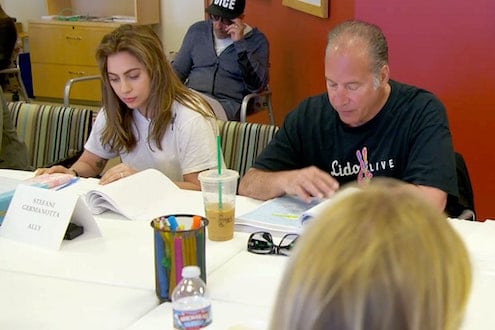
Generally, table reads can help identify script weaknesses such as:
- Plot holes
- Stiff dialogue
- Confusing storylines
- Tangents
- Out-of-character behaviour
- Boring scenes
A read-through will illuminate your content, catch any glaring weaknesses and offer a chance to fix them before cameras roll.
Take Notes During a Table Read
To make most of a table read you should take notes. You will be able to use these to work with during your rewrites.
- So note where the dialogue flows naturally and where people stumble over words.
- If you get laughs during certain scenes, make sure you mark down where jokes worked and where they didn’t.
- Highlight places in your script where you have questions for the director, the dramaturge, the dialect coach, or the music director.
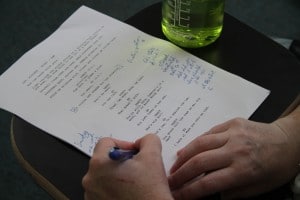
Remember, get someone else in, perhaps from the production team or another actor, to read action lines and dialogue for “bit” parts.
You’ll want to stay attentive during the read-through and try and act as an audience member seeing the script from the outside.
Plus, a read-through is most effectively done in one go, uninterrupted by questions, comments or improvements. This gives you a closer feel to the final product.
“You can’t fix a bad script after you start shooting. The problems on the page only get bigger as they move to the big screen.”
– Howard Hawks
So suggest that those attending the table read, unless there are major issues, write down their questions and leave them for the end of the read-through.
A good idea is to also audio or video record the session. You will inevitably miss out on some important comments which you will be able to refer back to with a recording.
Gain Feedback During a Table Read
A table read, unlike sending your script out only to hear back a month later, is an instant type of interaction.
Not only can you get feedback from the actors as they are speaking your words. But serving as the first occasion in which the cast and production team are gathered under one roof, a table read also gives everyone a chance to discuss the script.
So be sure to address the team at the beginning that you will have a Q&A type discussion after the full read.
Oftentimes, the people involved in the table readings won’t be used to giving feedback on a script. As you’ll be busy taking notes, maybe get a moderator to help keep the feedback running smoothly.
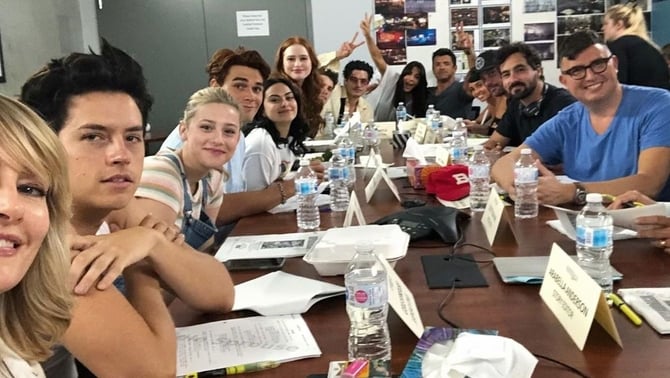
As a screenwriter, it is best for you to receive the feedback (whilst taking notes) and wait until everyone has given their opinions to ask any questions. If you repeatedly ask questions and interrupt the feedback, you won’t be able to listen.
And avoid defending your script. Even though it’s a natural response, you won’t hear the true and valid assessments of your script. So, take it in. And if you aren’t clear on a comment, ask a question for clarification.
Questions to ask your actors:
- Were your character’s motivations clear?
- Is your character arc clearly defined?
- Were you able to follow the plot?
- Are the protagonist and antagonist clearly defined?
Plus, record the feedback session as well as the reading. Use the scripts you handed out to get extra notes that the actors might have jotted down.
Use Notes from the Table Read for Rewrites
The feedback and notes gathered from a table read are only truly useful if you incorporate them into your rewrite, making a real difference to the overall quality of your screenplay.
Navigating through all the notes, some conflicting, will be difficult. You will have to choose what to take on board and what to ignore. But as a general rule, if multiple people give you the same note, you might want to pay close attention.
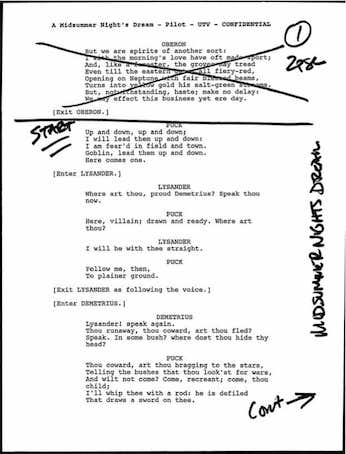
So give yourself a few days to reflect on your notes and what you learned. Then get to work on your script.
Use the feedback to focus your editing: for example, if your audience had questions about your characters, take some time to hone their wants and needs.
Be ruthless, and remember you’re not tackling a complete rewrite; you’re just fixing specific spots that don’t quite work. Endlessly rewriting will kill your story and slow down the production process.
So use the notes primarily to polish up your script.
A Table Read Can Confirm Casting Decisions
A read-through is not only beneficial for the screenwriter hearing their script aloud for the first time but it is also a great way to confirm casting decisions.
- In many cases, you will have already cast most, if not all, of your main roles. So listening to these actors inhabit their roles for the first time can help you confirm whether they have been properly cast or if adjustments need to be made.
- If there are roles that have not yet been cast, table reads can be a great way to allow an actor you are considering to read the role in question to determine if they might be right for it.
A screenwriter (and other important key players) can also get a sense of chemistry between actors. This is important for the production because there is often very little rehearsal time on set.
When you’re making a movie or a TV show, you want the cast to have chemistry. It’s hard to find ways to get strangers to embrace, especially when you’re working on refining the action and dialogue.
As an example of a nifty solution, for Lady Bird, Greta Gerwig gathered her cast together as often as possible, encouraging those who couldn’t make it to swap numbers and hang out. She stated, “I wanted them to feel connected…So much of acting is being unafraid to look silly.”
As you can see in the below read-through for Forgetting Sarah Marshall, the chemistry is there from the beginning.
- The actors might already have a connection or they might just naturally gel.
- Either way, a table read gives them an opportunity to explore the nuances of working together.
- This is particularly relevant in comedy, where some of the best humour will come from the unique interactions between certain cast members.
Gather Everyone Together at the Table Read
When your pre-production project heads for production, your table read is often the first in-person meeting for key players of the creative team. Therefore, take the time to make the most of a table read and invite all department heads and other crew working on the film.
These include your director of photography, production designer, costume designer, and hair and makeup artist. All of these department heads will need to see and hear who and what they will be working with.
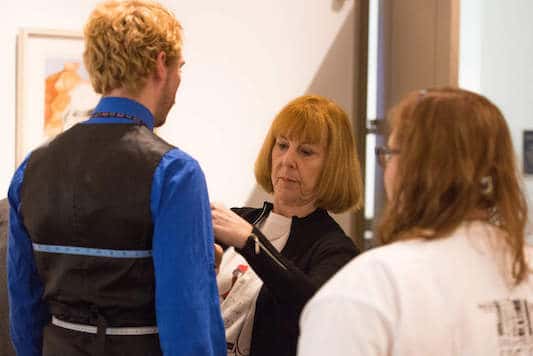
A read-through also stands as a great opportunity to obtain actor sizes and measurements, either on breaks or at the end of the table read. Be sure to maintain clear channels of communication with your actors if so.
“Any time you talk about the look of the film, it’s not just the director and the director of photography. You have to include the costume designer and the production designer.”
– Spike Lee
Being involved so early on and hearing the actors interpret the characters will energise the other artists and craftspeople, who are an integral part of the production.
Generally, the more people involved in the table read, the better chemistry the team has. In this way, it serves as a key team-building exercise.
Set the Tone For the Production
A table read might well be the first time the core creative team are coming together. Therefore, it is a great opportunity to increase morale and set the tone for the rest of the production.
By this we mean, your approach to the read-through – with call sheets, providing food, scripts and supplemental material. This sends a message that you are serious about your project.
Being supportive and encouraging will not only let everyone know you’re there to bring out the best in every performance but it will also make the table read productive, leading to a better production in the long run.
Generally, try to keep the atmosphere semi-casual. Everyone is there to have fun, be creative and push limits but yes, still work.
“In that moment you not only knew it was going to be something very special. But something that we all knew we had to live up to.”
– Josh Gad, Actor speaking about the table read from Beauty and the Beast.
Building the Excitement of Current Investors and Attracting New Ones
When you approach your read-through, know what you want to accomplish. If you simply announce, “We’re doing a table read,” end of story, you’ll still get value out of it, but you likely won’t maximize everyone’s time.
So, figure out your goals. Do you want to impress your investors and maybe even secure more money?
Your table read objectives determine your table read audience. Figure out what you want, and then invite people accordingly.
“We invite investors and put together our favorite actors to help sell the material.”
— Marci Liroff, Casting Director
So if you’re at the stage where you are trying to get the project off the ground a read can be very useful for gaining investors. Invite people who are interested in the project and put together some actors to help sell your material.
These readings can be scary for the cast so try and be transparent and open about the aim of the meeting.
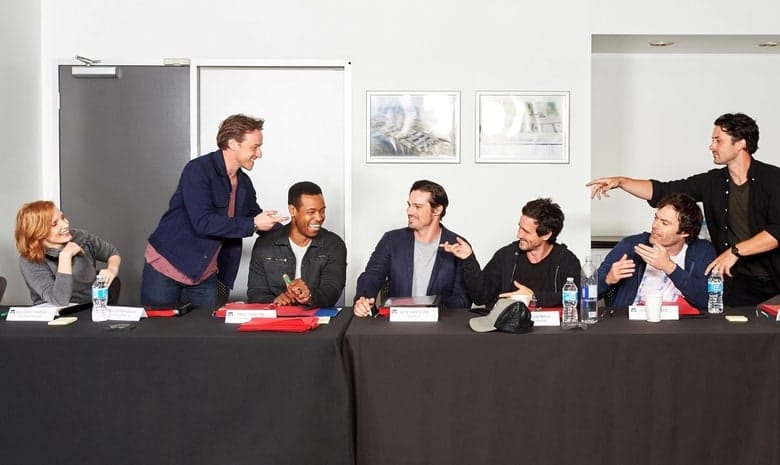
Also, financiers, studio executives or representatives from production companies can offer practical feedback about your script.
A table read can show the excitement surrounding a script and its entertainment value. It’s a great way to demonstrate why a film should be made and hence invested in.
Marketing Benefits
On top of creating a buzz during production, the recordings from your table read are useful for all the extra materials you will need for marketing and distribution.
- Behind-the-scenes of production, from beginning to end, is a great way to get additional videos for your Electronic Press Kit or other marketing materials.
- Some table reads are even used to conduct short on-camera interviews with the actors and crew. A few words, out of character, are very useful when the time comes to sell your film/TV series.
In other cases, a recording of a table read can preserve the magic of a cast and/or team.
Audience members are so accustomed to seeing performances in their final formats, so it can be very enjoyable to watch actors chatter through their characters’ famous lines for the very first time.
Table reads have been especially useful in the COVID-19 era as fundraising events. Audience members have been able to tune in to virtual table reads and TV show reunions to help cure the stay-at-home boredom and provide a solution to a lack of actual productions.
Table Reads Can Be Helpful at Early Stages of Script Development
A table read, although usually coming at the end of pre-production, can also be a great tool for a writer who is looking to gain new perspectives on their script.
For any script longer than sixty pages that has been through several drafts, it’s a good idea to get a table read together. It can help you feel confident in sending your script out for professional coverage.
It doesn’t make much sense to wait to get all that feedback only to find that the fifth draft still isn’t working. A table read can get the script out of your head and save you a lot of misery down the line.
But where can you find people to read, and for free or at a low expense?
- Check your personal contacts or someone you may have worked with in the past.
- You can connect with actors on social media or even acting groups and schools.
- Send an email to a few local theatre companies announcing your need for actors for a table read.
- Maybe even approach one of these groups with a donation or offer of lunch/dinner in exchange for a few hours of their service.

Aspiring actors will be enthusiastic to gain experience reading at a table read. Plus, you can double up on parts and cover more characters with fewer actors.
Some scriptwriters suggest that you don’t even need actors to conduct a table read. That any old friend, family member, or pet will do. Okay, maybe not anyone who is too introverted, as a poor reader makes even the best writer sound dull.
But letting your script come to life is a great way to get you unstuck. The table read will force yet another draft, moving your script forward.
In Conclusion
So as you can see, a table read is not only vital for you as a writer but for everyone involved in a production.
It’s a relatively simple yet highly effective method of finalising a screenplay or even helping with the early stages of script development.
New ideas bounce around and the vision of the story comes one step closer to being realized. There are no apparent negatives that can come out of this simple process, so why overlook it?
Plus, if you’re working through a global pandemic, or you’ve got actors and department heads unavailable to physically participate, a table read can also take place remotely.
Remember, make the most of it, stay open and aware, and adjust what needs to be adjusted. Next comes production and a table read is essential, considered preparation time for that often unpredictable and hectic stage.
In Summary
A table read (also known as a read-through) is an organized reading of a script in which the speaking parts, stage directions and scene headings are read out loud.
Table reads are generally attended by various members of the production team. These include: Cast, Screenwriter, Director, Producer, Production Designer, DOP, Casting Director, and Costume Designer. Some table reads are set up to attract investors or more money for the project. In these cases, Financiers are invited.
Table reads are an essential part of the script development and writing process. Usually seen as the last line of defence for a script before shooting starts, it offers writers the ability to fine-tune their stories, sharpen their dialogue and make other necessary adjustments.
– What did you think of this article? Share It, Like It, give it a rating, and let us know your thoughts in the comments box further down…
– Struggling with a script or book? Story analysis is what we do, all day, every day… check out our range of script coverageservices for writers & filmmakers.
This article was written by Mariona Foguet-Gonzalez and edited by IS Staff.
Get *ALL* our FREE Resources
Tackle the trickiest areas of screenwriting with our exclusive eBooks. Get all our FREE resources when you join 60,000 filmmakers on our mailing list!


Excellent and inspiring. I enjoyed it thoroughly.